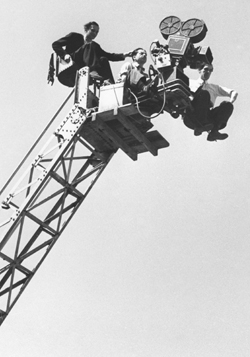A crane shot is achieved by a camera mounted on a platform, which is connected to a mechanical arm that can lift the platform up, bring it down, or move it laterally across space. An early crane shot predates the invention of the crane: in 1916, D.W. Griffith built a mobile counter-balanced elevator tower for Intolerance, because they didn’t have cranes yet. The camera and Griffith were atop the wooden two-story tower. As the grips push the tower forward, the camera drops down the elevator during the shot to create the first crane move. [ACTUALLY, LOIS WEBER MAY HAVE CREATED THE FIRST CRANE SHOT IN HYPOCRITES (1915), AT UNIVERSAL – MUST CHECK. ALSO NOTABLE FOR DOUBLE EXPOSURE EFFECTS AND FULL NUDITY ONSCREEN!]
In 1933, a small, mobile camera crane appeared on the Paramount lot, and throughout the 1930s, it was in common use, particularly in musicals and spectacular scenes in films such as Scarlet Empress (1934) or The Adventures of Robin Hood (1938). A common crane shot ends a scene by moving the camera upwards, revealing more of the particular set, very often as characters leave a particular location.
In 1958, Orson Welles used a crane to film the long take opening sequence of Touch of Evil, which begins on a close-up of a ticking time bomb and ends several minutes later with the explosion.
CLIP: (Example from Touch of Evil)
The tool which brought the crane to its modern potential is the Louma Crane, invented in 1973 in France by Jean-Marie Lavalou and David Samuelson. It was first used in the opening credits shot of Rosemary’s Baby (1973), and it had the ability to control the camera from remote, and rotate it 360 degrees – and especially downward in a way that was impossible before, with an operator on a platform. Before the invention of the Louma Crane however, Mikhail Kalatozov designed a ground-breaking mobile camera shot which could look downward in Soy Cuba (1964).
Wim Wenders’ Wings of Desire (1987) uses the Louma Crane to great artistic effect, suggesting the view of angels.
CLIP: (Example from Wings of Desire)
There is a notable crane shot in Quentin Tarantino’s Jackie Brown (1997) which connects two different parts of the set separated by a fence. The use of the crane allows Tarantino to underline the continuity between locations.
CLIP: (Example from Jackie Brown)
